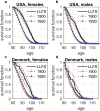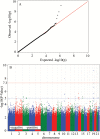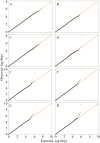Genetics of Human Longevity From Incomplete Data: New Findings From the Long Life Family Study
- PMID: 30299504
- PMCID: PMC6175028
- DOI: 10.1093/gerona/gly057
Genetics of Human Longevity From Incomplete Data: New Findings From the Long Life Family Study
Abstract
The special design of the Long Life Family Study provides a unique opportunity to investigate the genetics of human longevity by analyzing data on exceptional lifespans in families. In this article, we performed two series of genome wide association studies of human longevity which differed with respect to whether missing lifespan data were predicted or not predicted. We showed that the use of predicted lifespan is most beneficial when the follow-up period is relatively short. In addition to detection of strong associations of SNPs in APOE, TOMM40, NECTIN2, and APOC1 genes with longevity, we also detected a strong new association with longevity of rs1927465, located between the CYP26A1 and MYOF genes on chromosome 10. The association was confirmed using data from the Health and Retirement Study. We discuss the biological relevance of the detected SNPs to human longevity.
Figures




Similar articles
-
Genome-wide linkage analysis for human longevity: Genetics of Healthy Aging Study.Aging Cell. 2013 Apr;12(2):184-93. doi: 10.1111/acel.12039. Epub 2013 Feb 6. Aging Cell. 2013. PMID: 23286790 Free PMC article.
-
Association of common variants in TOMM40/APOE/APOC1 region with human longevity in a Chinese population.J Hum Genet. 2016 Apr;61(4):323-8. doi: 10.1038/jhg.2015.150. Epub 2015 Dec 10. J Hum Genet. 2016. PMID: 26657933
-
Replication of Genome-Wide Association Study Findings of Longevity in White, African American, and Hispanic Women: The Women's Health Initiative.J Gerontol A Biol Sci Med Sci. 2017 Oct 1;72(10):1401-1406. doi: 10.1093/gerona/glw198. J Gerontol A Biol Sci Med Sci. 2017. PMID: 27707806 Free PMC article.
-
TOMM40 genetic variants associated with healthy aging and longevity: a systematic review.BMC Geriatr. 2022 Aug 13;22(1):667. doi: 10.1186/s12877-022-03337-4. BMC Geriatr. 2022. PMID: 35964003 Free PMC article.
-
Understanding the genetics of APOE and TOMM40 and role of mitochondrial structure and function in clinical pharmacology of Alzheimer's disease.Alzheimers Dement. 2016 Jun;12(6):687-94. doi: 10.1016/j.jalz.2016.03.015. Epub 2016 May 4. Alzheimers Dement. 2016. PMID: 27154058 Review.
Cited by
-
Interplay between stress-related genes may influence Alzheimer's disease development: The results of genetic interaction analyses of human data.Mech Ageing Dev. 2021 Jun;196:111477. doi: 10.1016/j.mad.2021.111477. Epub 2021 Mar 30. Mech Ageing Dev. 2021. PMID: 33798591 Free PMC article.
-
Genetic loci and metabolic states associated with murine epigenetic aging.Elife. 2022 Apr 7;11:e75244. doi: 10.7554/eLife.75244. Elife. 2022. PMID: 35389339 Free PMC article.
-
Genetics of physiological dysregulation: findings from the long life family study using joint models.Aging (Albany NY). 2020 Apr 1;12(7):5920-5947. doi: 10.18632/aging.102987. Epub 2020 Apr 1. Aging (Albany NY). 2020. PMID: 32235003 Free PMC article.
-
How are APOE4, changes in body weight, and longevity related? Insights from a causal mediation analysis.Front Aging. 2024 Mar 1;5:1359202. doi: 10.3389/fragi.2024.1359202. eCollection 2024. Front Aging. 2024. PMID: 38496317 Free PMC article.
-
The Role of TOMM40 in Cardiovascular Mortality and Conduction Disorders: An Observational Study.J Clin Med. 2024 May 29;13(11):3177. doi: 10.3390/jcm13113177. J Clin Med. 2024. PMID: 38892888 Free PMC article.
References
Publication types
MeSH terms
Substances
Grants and funding
LinkOut - more resources
Full Text Sources
Miscellaneous

